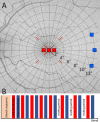Fundus-Controlled Dark Adaptometry in Young Children Without and With Spontaneously Regressed Retinopathy of Prematurity
- PMID: 31293816
- PMCID: PMC6602151
- DOI: 10.1167/tvst.8.3.62
Fundus-Controlled Dark Adaptometry in Young Children Without and With Spontaneously Regressed Retinopathy of Prematurity
Abstract
Purpose: We correlate dark adaptation course with foveal morphologic alterations in preterm and term-born children using a modified fundus-controlled perimeter and spectral domain-optical coherence tomography (SD-OCT) imaging.
Methods: We performed fundus-controlled chromatic dark adaptometry in premature children aged 6 to 13 years without retinopathy of prematurity (no-ROP; n = 61) and with spontaneously regressed ROP (sr-ROP, n = 29), and in 11 age-matched term-born children. The degree of macular developmental arrest (MDA), defined as a disproportion of the outer nuclear layer to inner retinal layers in the fovea (ONL+/IRL-ratio), was analyzed with the DiOCTA tool in SD-OCT scans.
Results: Children with MDA showed a flatter dark adaptation course progression with a significant rod-mediated sensitivity recovery delay (0.0113 vs. 0.0253 dB/s; P < 0.001). Preterm-born children with regular foveal morphology reached the final rod-mediated dark-adapted threshold at 12 minutes after bleach at 18.8 dB, compared to after 18.7 minutes at 17.6 dB in children with MDA (no significant difference in final threshold; P = 0.773). The cone-mediated dark adaptation progression showed a significant lower final threshold in children with MDA (6.0 vs. 8.1 dB; P = 0.004).
Conclusions: Changes in dark adaptation were seen in the presence of MDA observed in premature children in the no-ROP and sr-ROP groups. MDA in former premature children is associated with functional deficits of cone and rod photoreceptor visual pathways.
Translational relevance: Morphologic alterations in the central retina of premature children, evident in SD-OCT, are associated with long-term functional deficits in the rod and cone pathways, particularly evident in the rod dark adaptation course measured at 12° eccentricity. This indicates a more widespread retinal functional pathology not limited to the fovea, but occurring together with foveal alterations best defined as MDA.
Keywords: dark adaptometry; macular developmental arrest MDA; optical coherence tomography; prematurity; retinopathy of prematurity.
Figures





References
-
- World Health Organization. Vision 2020: Global Initiative for the Elimination of Avoidable Blindness Action Plan 2006-2011. Geneva: WHO Library; 2007.
-
- Reisner DS, Hansen RM, Findl O, Petersen RA, Fulton AB. Dark-adapted thresholds in children with histories of mild retinopathy of prematurity. Invest Ophthalmol Vis Sci. 1997;38:1175–1183. - PubMed
-
- Hansen RM, Fulton AB. Rod-mediated increment threshold functions in infants. Invest Ophthalmol Vis Sci. 2000;41:4347–4352. - PubMed
LinkOut - more resources
Full Text Sources
Research Materials
Miscellaneous

